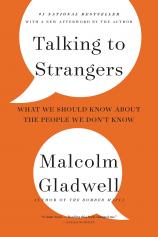Talking to Strangers: What We Should Know about the People We Don't Know
Review
Talking to Strangers: What We Should Know about the People We Don't Know
Ever since the publication of his first book, THE TIPPING POINT, in 2000, New Yorker staff writer Malcolm Gladwell has produced, with impressive regularity, works whose goal seems to be upending his readers’ thinking on some subject that has attracted his deep curiosity. Blending the ability to translate social science research to a general audience with an engaging storytelling style, Gladwell has authored a string of bestsellers whose insights have informed and entertained, while insinuating their way into popular discourse.
Gladwell’s latest, TALKING TO STRANGERS, follows the same well-trod path. Though it doesn’t directly address America’s troubling tribalism, it somehow seems well-suited to our current predicament, a time when, as he says, “we are now thrown into contact all the time with people whose assumptions, perspectives, and backgrounds are different from our own.”
Drawing from a disparate assortment of both well- and lesser-known examples, Gladwell seeks to understand why our strategies for dealing with what he calls the “stranger problem,” i.e., communicating with people we don’t know, are fraught, at best, with formidable challenges, and, at worst, with life-threatening danger. Unfortunately, despite all the intriguing evidence he amasses, Gladwell doesn’t deliver on his ambitious promise.
"It’s a book that’s hard to put down while reading it, but one that leaves a sense of frustration that we’re not much closer to solving this problem of dealing with strangers in our lives than we were when we picked it up."
The tragic story of Sandra Bland bookends the narrative. On July 10, 2015, Bland, a 28-year-old African-American from Illinois, was pulled over outside Prairie View, Texas, by state trooper Brian Encinia for failure to signal a lane change. Their encounter, captured on video, rapidly and disastrously escalated, resulting in Bland’s arrest. Three days later, she was found hanged in her prison cell, the victim of a suicide.
As Gladwell explains it, this confrontation --- between a police officer who “did exactly what he was trained to do,” however ill-advised that response may have been in the moment, and a young woman whose behavior, however justified it may have been in that difficult setting, placed her in jeopardy --- epitomized how two strangers “relied on a set of strategies to translate one another’s words and intentions” and how, in that instance “something went very wrong.” It’s a story he suspects most of us have forgotten, but that continues to trouble him.
In trying to understand the human failures that set in motion the chain of events ending in Sandra Bland’s death, Gladwell identifies “the underlying problem we have in making sense of people we do not know.” To do so, he sets out to solve what he calls two “puzzles,” both of which seem only tangentially related to the case, even as they launch us on an engrossing journey of Gladwellian erudition. The first is why we can’t tell when someone is lying to us; the second is the paradox that meeting a stranger sometimes can make us worse at making sense of that person than not meeting them.
The episodic narrative of TALKING TO STRANGERS reaches as far back as the encounter between Montezuma II and Hernán Cortés in 16th-century Mexico and is as current as contemporary stories that include those of Bernard Madoff, Amanda Knox and Sylvia Plath. We meet Cuban spies, ponder how Neville Chamberlain so profoundly misjudged Hitler’s intentions, and even deconstruct an episode of “Friends” for what it reveals about reading facial expressions. Gladwell wades into the controversy surrounding the Jerry Sandusky child abuse scandal at Penn State, stating, controversially, that university president Graham Spanier and the other administrators criminally charged with failing to report Sandusky’s conduct “deserve our sympathy, not our censure.”
Introducing concepts like “default to truth” (our tendency to believe that people are being honest with us), “transparency” (the notion that we can understand people from their behavior and demeanor) and “coupling” (the idea that behaviors are linked to a specific context), Gladwell lays the groundwork for a better understanding of our persistent misjudgments about people we don’t know.
In presenting the Madoff case, for example, he explains how the deep skepticism of whistleblower Harry Markopolos, who identified Madoff’s Ponzi scheme decades before the fraud was exposed, is aberrational in a world in which most people assume those they encounter are truthful. Despite the absence of DNA evidence, Amanda Knox spent almost four years in an Italian prison because her unusual behavior made her an obvious suspect in the savage murder of her roommate. And according to Gladwell, Sylvia Plath’s story illustrates how behaviors --- in her case, suicide by asphyxiation because of the availability of a highly lethal form of natural gas in British homes in the 1960s --- are inextricably tied to surrounding circumstances. This final story slips effortlessly into a discussion of the flawed policing strategies that contributed to Brian Encinia’s mishandling of Sandra Bland’s traffic stop.
It’s all fascinating stuff. But in the end, each of the tales Gladwell chooses to tell seems more interesting for its discrete content than for its role in proving his overarching thesis that “Strangers are not easy.” For all its undeniably provocative excursions, TALKING TO STRANGERS never quite succeeds in gathering up those pieces and assembling them into a completed puzzle. It’s a book that’s hard to put down while reading it, but one that leaves a sense of frustration that we’re not much closer to solving this problem of dealing with strangers in our lives than we were when we picked it up.
Reviewed by Harvey Freedenberg on September 26, 2019
Talking to Strangers: What We Should Know about the People We Don't Know
- Publication Date: September 28, 2021
- Genres: Nonfiction, Psychology, Social Sciences
- Paperback: 416 pages
- Publisher: Back Bay Books
- ISBN-10: 0316299227
- ISBN-13: 9780316299220




